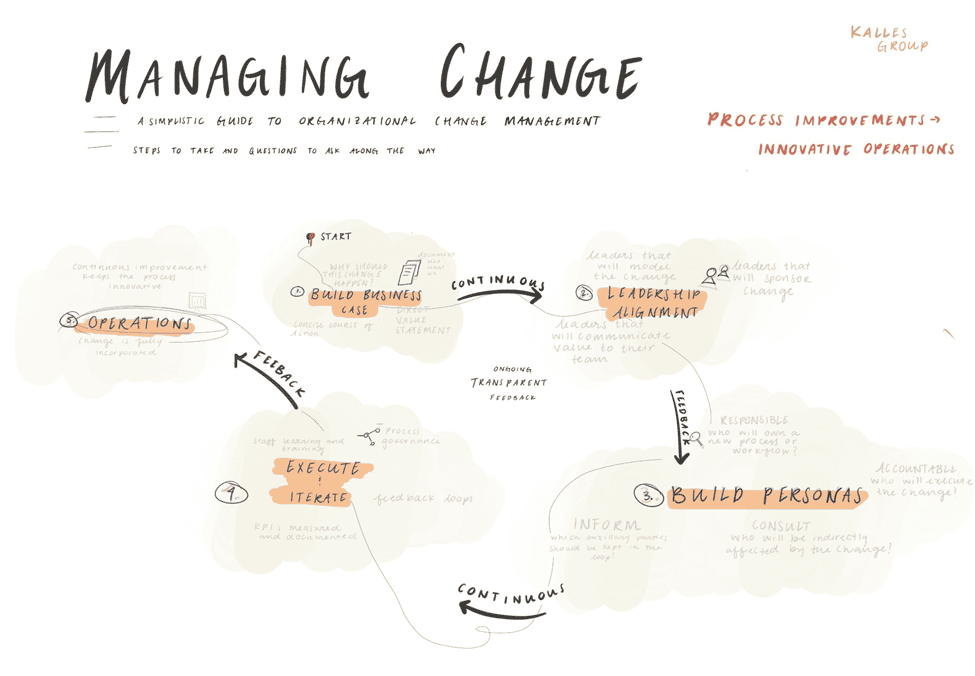Change is an ongoing, organization-wide practice that drives innovation and competitive market placement. To constantly evolve, iterate, and adjust is to manage a competitive edge — making change a daunting yet necessary undertaking.
Change management is a dexterous process. Managing change across operations requires emotional intelligence, situational awareness, data analysis, a campaigning attitude, and a strong team. Using a nuanced understanding of the professional landscape, change managers can tell when things are likely to go smoothly and when a turbulent change may be necessary.
This article outlines operational change management and the general steps taken to execute process change. If you would like to learn more about specific change management services or receive guidance for your organization, we are happy to answer your questions and share our expertise.
Why a well-thought-out approach to organizational change is necessary
Change is difficult — both for leaders and employees — and it’s happening at faster and faster rates. From the breakneck speed of technological advancement to the impact of economic uncertainty, it’s almost impossible for organizations to envision sticking to the same plan for a whole year.
Here are just a few examples of change within the domain of information technology:
- AI adoption for internal collaboration and individual productivity
- Meeting, chat, and collaboration platform changes
- Operating system or device upgrades
- On-campus meeting room system changes
- Cloud migrations
Without clear communication and support, employees may be left wondering why the change is important and whether it will interfere with their ability to do their jobs efficiently. This can create resentment and lead to team dysfunction.
By taking people’s concerns seriously, encouraging active collaboration, and — most importantly — having a concrete framework in place, you can avoid the pitfalls of mismanaged change and set up your organization for long-term success in a turbulent world.
Frameworks for change management: How to build one that works
Change management processes are often presented in an idealized way (see the associated graphic for an example). In practice, however, complications arise, timelines are extended, and objectives can change.

Generally speaking, change management should follow the same framework each time. Start with a clear objective, align leaders (these will be the people that drive and sponsor your change), over-communicate with your varying audiences, and execute the process change (bearing in mind that you will likely have to tweak the process once it reaches operations).
It’s also important to address the environmental and situational awareness for handling change. Assessing behavior starts with an environmental analysis. Measure the emotion, confidence, and capacity of leaders first. Then move into persona work, which involves creating a set of profiles representing the types of people who will be impacted by the change.
Be sure to consider how much change is currently happening and whether your audience and leadership has the bandwidth to take on and sponsor another transformation.
10 Questions for assessing your change management strategy
To develop your change management framework, you need to get a clear understanding of the purpose of the change, the individual(s) responsible for making it happen, and how they plan to go about it. The following questions should have clear answers, and all involved should give the same answer when asked.
- What will this change achieve?
- Why is this change important?
- Who is responsible for the change?
- Who is executing the change?
- Who is participating in a new system?
- Who will read out the metrics of the system?
- Which processes will retire?
- Which processes will be modified?
- How will we execute the change?
- How will these processes be governed?
Designing new change management processes and guidelines
Programmatic and process changes require holistic modeling and governance. Process should be approachable and transparent, and clear guidance and training are paramount. Onboarding and training resources should be clear, concise, and updated regularly.
By clearly understanding and communicating the purpose of the change and your framework for execution, you can keep your team committed to its success and shore up your organization’s processes for undergoing future transformations. Given that change is a constant, the ability to navigate it smoothly is key for staying competitive.
For change management assistance, reach out to our team.
